The compounds having a highly specific hydro-philic group are named as
Auxins
Cytokinins
Gibberellins
Ethylene
The correct Answer is:B
Step-by-Step Solution:
1. Understanding Hydrophilic Groups:
- Hydrophilic groups are parts of molecules that are attracted to water and can dissolve in it. These groups typically contain polar bonds and can form hydrogen bonds with water.
2. Identifying the Options:
- The options provided are:
- A) Oxins
- B) Cytokinins
- C) Gibberellins
- D) Ethylene
3. Analyzing Each Option:
- Oxins:
- Oxins are plant hormones that promote apical dominance but do not have a highly specific hydrophilic group. Thus, they are not the correct answer.
- Cytokinins:
- Cytokinins are known for promoting cell division and are present in roots and shoots. Their structure includes hydroxyl (OH) groups, indicating they have a high hydrophilic nature, which allows them to readily absorb and transport water. This makes them a strong candidate for having a highly specific hydrophilic group.
- Gibberellins:
- Gibberellins are involved in fruit shape, ripening, and elongation but do not have a highly specific hydrophilic group.
- Ethylene:
- Ethylene is a gaseous plant hormone and does not possess a hydrophilic group.
4. Conclusion:
- Based on the analysis, Cytokinins are the compounds that have a highly specific hydrophilic group due to their structure that includes hydroxyl groups.
Final Answer: Cytokinins
---
- Hydrophilic groups are parts of molecules that are attracted to water and can dissolve in it. These groups typically contain polar bonds and can form hydrogen bonds with water.
- The options provided are:
- A) Oxins
- B) Cytokinins
- C) Gibberellins
- D) Ethylene
- Oxins:
- Oxins are plant hormones that promote apical dominance but do not have a highly specific hydrophilic group. Thus, they are not the correct answer.
- Cytokinins:
- Cytokinins are known for promoting cell division and are present in roots and shoots. Their structure includes hydroxyl (OH) groups, indicating they have a high hydrophilic nature, which allows them to readily absorb and transport water. This makes them a strong candidate for having a highly specific hydrophilic group.
- Gibberellins:
- Gibberellins are involved in fruit shape, ripening, and elongation but do not have a highly specific hydrophilic group.
- Ethylene:
- Ethylene is a gaseous plant hormone and does not possess a hydrophilic group.
- Based on the analysis, Cytokinins are the compounds that have a highly specific hydrophilic group due to their structure that includes hydroxyl groups.
Topper's Solved these Questions
- PLANT GROWTH AND DEVELOPMENT BOOK - AAKASH SERIESCHAPTER - PLANT GROWTH AND DEVELOPMENT EXERCISE - EXERCISE -II (ABA )
5 Videos
- PLANT GROWTH AND DEVELOPMENT BOOK - AAKASH SERIESCHAPTER - PLANT GROWTH AND DEVELOPMENT EXERCISE - EXERCISE -II (PHOTOPERIODISM)
14 Videos
- PLANT GROWTH AND DEVELOPMENT BOOK - AAKASH SERIESCHAPTER - PLANT GROWTH AND DEVELOPMENT EXERCISE - EXERCISE -II (GIBBERELLINS )
12 Videos
- PHOTOSYNTHESIS IN HIGHER PLANTS BOOK - AAKASH SERIESCHAPTER - PHOTOSYNTHESIS IN HIGHER PLANTS EXERCISE - Exercise - III
27 Videos
- PRINCIPLES AND PROCESSES BOOK - AAKASH SERIESCHAPTER - PRINCIPLES AND PROCESSES EXERCISE - Exercise - III (Previous AIPMT/NEET Questions)
26 Videos
Similar Questions
The compounds whose structures are shown below, incorporate a variety of functional groups. The question on the right ask you to identify which compounds have a specific functional group. For each compound that has the designed group, enter the appropriate number. The aromatic rings should not be counted as double bonds.
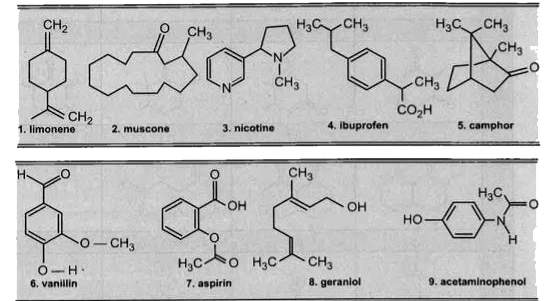
Which have a ketone carbonyl group ?
View SolutionThe compounds whose structures are shown below, incorporate a variety of functional groups. The question on the right ask you to identify which compounds have a specific functional group. For each compound that has the designed group, enter the appropriate number. The aromatic rings should not be counted as double bonds.

Which have an aldehyde carbonyl group?
View SolutionThe compounds whose structures are shown below, incorporate a variety of functional groups. The question on the right ask you to identify which compounds have a specific functional group. For each compound that has the designed group, enter the appropriate number. The aromatic rings should not be counted as double bonds.
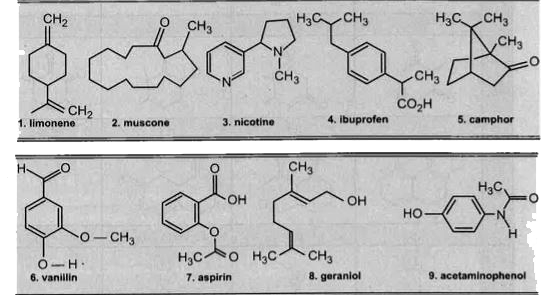
Which have a hydroxy group ?
View SolutionThe compounds whose structures are shown below, incorporate a variety of functional groups. The question on the right ask you to identify which compounds have a specific functional group. For each compound that has the designed group, enter the appropriate number. The aromatic rings should not be counted as double bonds.
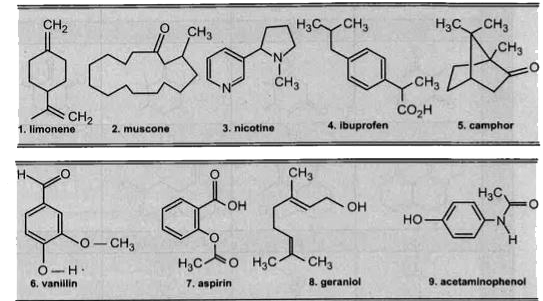
Which have ether groups ?
View SolutionThe compounds whose structures are shown below, incorporate a variety of functional groups. The question on the right ask you to identify which compounds have a specific functional group. For each compound that has the designed group, enter the appropriate number. The aromatic rings should not be counted as double bonds.
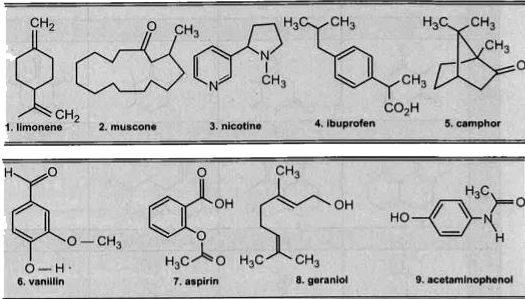
Which have an amide group?
View SolutionThe compounds whose structures are shown below, incorporate a variety of functional groups. The question on the right ask you to identify which compounds have a specific functional group. For each compound that has the designed group, enter the appropriate number. The aromatic rings should not be counted as double bonds.

Which have carbon-carbon double bonds ?
View SolutionThe compounds whose structures are shown below, incorporate a variety of functional groups. The question on the right ask you to identify which compounds have a specific functional group. For each compound that has the designed group, enter the appropriate number. The aromatic rings should not be counted as double bonds.
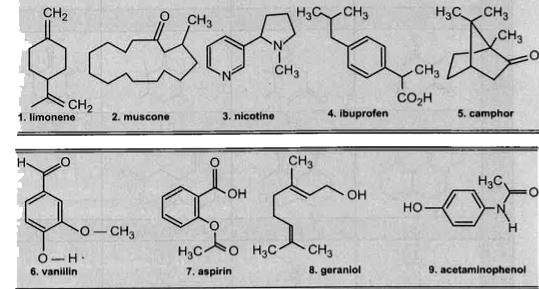
Which have aromatic rings ?
View SolutionAn organic compound 'A' having molecular formula C5H10O6 on acetylation forms a compound having molecular weight 334. Number of hydroxy group (-OH) in the compound 'A' is:
View SolutionWrite the structures of the compounds having the following names:
3-phenylpropanal
View SolutionWrite the structures of the compounds having the following names:
3-phenyl-1-bromopropane
View Solution
